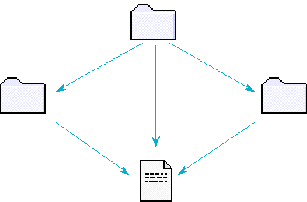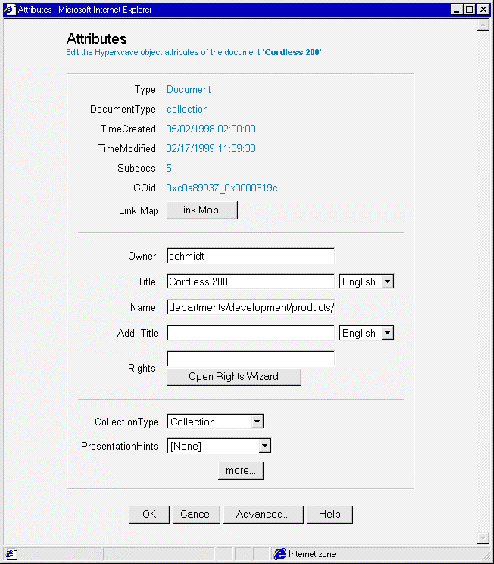





1.1.1 Dynamic Structure
The structure of Hyperwave Information Server is dynamic, displaying as a
flexible hierarchy of objects represented by folders and icons. The dynamic
nature of Hyperwave Information Server is what makes it such an efficient
solution for information management.
Hyperwave Information Server eliminates problems of static structure by the
introduction of structural elements and an object repository.
The
structural elements on the Hyperwave Information Server are called
collections. A collection contains a number of other elements, which
could be documents or other collections. There are also a number of types of
collection, which have particular attributes or behave in a certain way. These
are Collection, Sequence, Language Cluster, MultiCluster, and
AlternativeCluster. For more information on collection types, see
page
116.
Figure 1 shows a simple collection. A collection is very much like a directory
or folder in a hierarchical file system. However, on the Hyperwave Information
Server, an item may be a member of more than one collection (such as the text
item in Figure 1). When you access a collection (with a URL), it is displayed
as a menu-like table of contents, i.e. the user is given a choice of
sub-elements. Of course the sub-elements could again be collections. This is
what is called the collection hierarchy.
 Figure 1: The Collection structure element
Hyperwave
Information Server differentiates between structural and referential
hyperlinks, ensuring the structural links are maintained automatically by the
server. Authors need only be aware of referential links, giving them more time
to concentrate on content.
Figure 1: The Collection structure element
Hyperwave
Information Server differentiates between structural and referential
hyperlinks, ensuring the structural links are maintained automatically by the
server. Authors need only be aware of referential links, giving them more time
to concentrate on content.
- structural (sometimes also called organizational) hyperlinks are used to
organize the content. This type of hyperlink is commonly found in tables of
contents, navigation bars, frames, "next", "previous", "up", and "home" links.
- referential ("real") hyperlinks are cross-references, emanating from areas
(e.g., words) in a document, such as "see also section 4". This is what
hyperlinks were originally intended for.
Unlike
many other Web-based systems, Hyperwave Information Server stores its documents
not just as plain files in a file system, but in an object-oriented repository
(a kind of database). Also stored in the repository are information objects.
These objects carry metadata about documents on the server. Metadata is stored
in the form of attribute name and value pairs, e.g. Title=Company Report
(where Title is the attribute name and Company Report is the value).
Documents on the Hyperwave Information Server can be of any type.
The list of attributes is extensible, in that you can create attributes to suit
your particular information management needs. We may classify attributes into
the following groups:
TYPES OF ATTRIBUTES
- User-defined attributes: The user in this case is the application
developer, who may define any number of attributes. These attributes can be
attached to all or just some objects. Within this group we may distinguish
between:
- Indexed attributes, which can be searched for. This property has to be
specified by the system administrator.
- Non-indexed attributes, which cannot be searched for and have only
informational purpose.
- System-defined attributes: These attributes have meaning to the system,
i.e. they are set and/or interpreted by the system itself. The system also
defines which of them need to be indexed. We can further refine this group
to:
- Read-only attributes, the values of which are set and maintained by the
system and cannot be changed by the user. Examples include the attributes
TimeCreated, TimeModified, and Size.
- Read-Write attributes, which can be set by the user (see Figure 2) and are
interpreted by the system. Examples include Name (the URL of the object), Title
(is displayed in collection listings and other places), Rights (defines access
permissions), and TimeExpire (a date after which the object becomes
invisible).
 Figure 2: Modify A
ttributes
dialog box
The ability to define arbitrary attributes (metadata) for all kinds of objects
prepares Hyperwave Information Server for many applications, which would
otherwise require the functionality of a relational database. For more
information on Attributes, see
page
139.
Figure 2: Modify A
ttributes
dialog box
The ability to define arbitrary attributes (metadata) for all kinds of objects
prepares Hyperwave Information Server for many applications, which would
otherwise require the functionality of a relational database. For more
information on Attributes, see
page
139.
EXAMPLE
A typical example, found in almost any intranet, is an employee directory.
Every employee in the directory is represented by an object with user-defined
attributes such as Lastname, Firstname, Middlename,
Phone, Fax, Email, and Department, which are all
indexed and thus searchable. The objects are inserted into a collection with a
modified search dialog, which lets you search for combinations of the above
attributes. For a better implementation, rather than inserting all employees
into one large collection, you could have a collection hierarchy representing
the company hierarchy, with one collection for every department. In this way,
users could browse the directory instead of searching, if they preferred. The
employee objects could also be documents or MultiClusters (see
page
136),
so that you could offer additional information (e.g., pictures, work
descriptions) for each employee.
Another
important feature that comes with the use of structural elements in the
Hyperwave Information Server is the clear separation of information (content)
and its presentation (layout, navigation). The document management community
has traditionally separated content and layout (just think of the concepts of
SGML and now XML, where the document defines the content and a style sheet
defines the layout). This distinction is not possible in static HTML documents,
since HTML defines both content and its presentation (including navigation).
Hyperwave Information Server lets authors focus on supplying the content: the
presentation (with layout and navigation) is performed by the system, according
to the exact specifications of system administrators.
ADVANTAGES
What are the advantages of having content and presentation separated?
- With the Hyperwave Information Server, you need only concern yourself with
providing content. This makes for a very effective intranet solution as you,
the user, are not dependent on a Webmaster to upload your documents to the
server. Also, you can use the Hyperwave Information Server efficiently without
worrying about such issues as user interface design, graphics, corporate
identity, navigation, complex authoring tools, and details of HTML.
- The presentation, including layout and navigation, is defined by an
administrator in advance, and is therefore consistent throughout the site. This
means that all pages conform to a certain layout (including corporate
identity), and it also means that you can rely on a consistent user interface,
always following the same steps for navigation and other tasks.
- Since the layout is not defined directly in the documents, it can easily
be changed afterwards without having to touch the documents themselves. This
means that you can immediately start with a prototype system, have users insert
information, and worry about the details of layout later.
- You can also customize different interfaces to the very same information
for different user communities. In other words, if partners or customers
outside your company have extranet access to your server, they can see
information presented in a different way than the employees of the company see
it in the intranet. Maybe external visitors to the server will only be able to
browse the information, whereas internal employees will have the rights to
modify documents, and possibly make administrative changes. Users can even
choose and configure their favorite interface while they are using the server.
More information about customizing the user interface can be found in the
Hyperwave Programmer's Guide.
CONSISTENCY
The collection listing is dynamically generated by the system. This means that
it is always consistent. When you delete something, the corresponding entry or
entries are also removed. When you insert something into a collection, its
entry appears in the collection listing. Since information objects inserted
into Hyperwave Information Server's repository always have to be put into at
least one collection, there can be no orphaned objects.
REDUCED MAINTENANCE EFFORT
All this is done with simple insert and delete operations. There is no need to
manually maintain a table of contents, and no opportunity to make a mistake in
doing so, such as forgetting to update a link when you move an object.
SECURITY
Unlike in a hypertext model (Figure 3), there is no need to edit other people's
documents in order to insert a new document. This allows for a strong security
model that supports collaborative authoring.
NAVIGATION
While it is possible to override the collection's automatic table of contents
menu with a manually designed page, the majority of a large Web site's
collections will use the automatically generated collection listings in order
to reduce the overall graphic design work required. For the users this means a
consistent way of navigating the hierarchy.
In addition, Hyperwave Information Server also supports a tree-like navigation
of the collection hierarchy (similar to the Windows Explorer). This makes it
very easy to navigate the collection hierarchy (and also to manipulate it, if
you have the appropriate access rights).
MULTIPLE VIEWS
The collection hierarchy can also be seen as a classification of the
information in the system. Since a document or collection may be member of a
number of collections, such a classification need not be unique. There can be
multiple views (classifications) of the same information space. After all, why
should a company's top management have the same view as a specialized employee?
SCOPE
The collection hierarchy in Hyperwave Information Server provides the ability
to define scope in terms of the logical structure of the information
space. For example, we may specify that a certain search operation should be
restricted to a certain part of the information space, i.e. only documents in a
certain collection. Likewise, we can use the scope to perform arbitrary
operations on a certain part of the information space, or to define access
permissions.
HIGHLY DYNAMIC
The collection listing is not modified when you insert an element. Instead, the
listing is generated dynamically when a user accesses the URL associated with
the collection. When the collection listing is dynamically created, such things
as the collection sort order, the identity of the user and their preferences,
and the validity of the member item are taken into account. Sort order simply
refers to how a collection is sorted: by title, creation date, etc. Only items
to which the user has rights will be listed; some objects may only be
accessible at certain times (otherwise they are invisible). Essentially, this
means that for different users the collection listing may look different at any
one time.
REUSABLE COMPONENTS
Of course, it now becomes possible to re-use certain parts of the collection
hierarchy in many different places. For example, in a Web Based Training
application, parts of a lesson may appear in multiple lessons. Still, they are
not physical copies, but the very same items.






|
|
Benutzer: Gast •
Besitzer: hwsystem • Zuletzt gešndert am:
|
|
|













